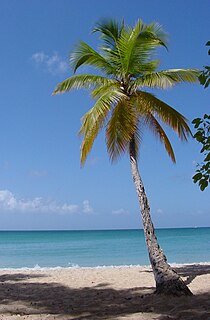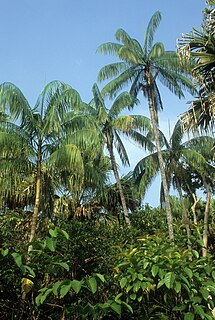
The Arecaceae is a family of perennial flowering plants in the monocot order Arecales. Their growth form can be climbers, shrubs, tree-like and stemless plants, all commonly known as palms. Those having a tree-like form are called palm trees. Currently 181 genera with around 2,600 species are known, most of them restricted to tropical and subtropical climates. Most palms are distinguished by their large, compound, evergreen leaves, known as fronds, arranged at the top of an unbranched stem. However, palms exhibit an enormous diversity in physical characteristics and inhabit nearly every type of habitat within their range, from rainforests to deserts.

Rattan, also spelled ratan, is the name for roughly 600 species of Old World climbing palms belonging to subfamily Calamoideae. The greatest diversity of rattan palm species and genera are in the closed-canopy old-growth tropical forests of Southeast Asia, though they can also be found in other parts of tropical Asia and Africa. Most rattan palms are ecologically considered lianas due to their climbing habits, unlike other palm species. Though a few species also have tree-like or shrub-like habits.

Calamus is a genus of flowering plants in the palm family Arecaceae that are among several genera known as rattan palms. There are an estimated 400 species in this genus, all native to tropical and subtropical Asia, Africa, and Australia. They are dioecious, mostly leaf-climbing lianas with slender, reedy stems. To aid scrambling some species have evolved hooks on the underside of the midrib, or more commonly by modified "pinnae" or tendrils in the form of stout, backward-pointing spines. These stems may grow to lengths of 200 metres.

Daemonorops was a genus of rattan palms in the family Arecaceae. Its species are now included within the genus Calamus.

Oncosperma is a genus of flowering plant in the family Arecaceae. It contains the following species, native to Southeast Asia and Sri Lanka:

Plectocomia is a genus of flowering plant in the family Arecaceae native to China, the Himalayas, and Southeast Asia. Plants are dioecious, with male and female flowers produced on separate individuals. It contains the following known species:

Korthalsia is a clustering genus of flowering plant in the palm family spread throughout Southeast Asia. It is a highly specialized rattan with some species known to have an intimate relationship with ants, hence the common name ant rattan. High-climbing and armed with spines, the genus is named for the Dutch botanist P. W. Korthals who first collected them from Indonesia.

Myrialepis is a monotypic genus of flowering plant in the palm family, the single species, Myrialepis paradoxa, native to Southeast Asia. The genus name is a combination of the Greek words meaning "innumerable" and "scale", a description of the fruit, and the epithet is Latin for "paradox".

Oncosperma tigilarium is an Asian species of palm tree in the family Arecaceae.
Climbing palms are genera in the family Arecaceae that grow as lianas. "Initially erect, the slender stems seek out trees for support and climb up into the forest canopy by means of recurved hooks and spines growing on the stem, leaves and inflorescences. In all climbing palms the leaves are pinnate and grow along the stem instead of forming a dense crown. The stems of climbing palms, more often referred to as canes, are solid in contrast to bamboo poles which are almost always hollow." "The majority of climbing palms are also clumping palms [and sympodial], sending out new shoots from [below ground as suckers]." "About 600 species of palms in [16] genera have a climbing growth habit. Most noteworthy is the genus Calamus--the largest genus in the palm family with approximately 350 described species--source of nearly all commercial rattan."
Plectocomia pierreana is a species of liana in the Arecaceae, or palm tree, family. It is a spiny climber, with either a single stem or a cluster of stems up to 35 m in length, stems are 1 to 9 cm in diameter. Its spines are up to 2 cm long.
Pinanga sylvestris is a species of tree in the Arecaceae, or palm tree, family. It grows 2-6 m tall, sometimes in bundles, shade tolerant, from Meghalaya (India) to Thailand, Cambodia, Vietnam, Laos and Zhōngguó/China. In Thailand it is recorded in the Khao Soi Dao Wildlife Sanctuary, in Chanthaburi Province, as a very common mid-storey tree in the Quercus semiserrata-dominated rainforest at 1,400 to 1,540 m. In Cambodia it occurs uncommonly in coastal vegetation communities, but is common in dense and semi-dense evergreen rainforest in the lowlands and at moderate altitude. The palm grows in similar dense and semi-dense communities in Laos and Vietnam. On the mountain of Ngọc Linh in Quảng Nam Province of Vietnam, it dominates the ground layer of low montane broadleaf evergreen forest, that occurs from 150 to 1000m.
A liana in the Arecaceae, or palm, family, Korthalsia bejaudii is an endemic growing in the forests of Cambodia, noted from Kampong Cham Province. The species is distinguished by shortened, truncate ocrea that do not disintegrate and possessing flattened spines, crowded near the tip, and leaves that are the same colour either side.
A large, very high liana, or "climbing tree" in the palm family, Korthalsia laciniosa occurs in the closed forests of Java, Sumatra, the Philippines, Malay Peninsula, Vietnam, Cambodia and elsewhere in Indochina, and the Nicobar and Andaman Islands.
Calamus viminalis, one of many Calamus species commonly referred to as rattan, is a plant of the Arecaceae, or palm, family native to: Java and Bali in Indonesia; Peninsular Malaysia; all parts of Thailand; Cambodia; Cochinchina and Central Annam in Vietnam; all parts of Laos; Myanmar; Bangladesh; Andaman and Nicobar Islands; North-east, North-central, and South India; and probably north-west and south Yunnan in China.
Calamus tetradactylus is a climbing plant in the Arecaceae, or palm, family, and is part of a subfamily, Calamoideae, whose members are usually called rattans in English. It is native to southeast and east Thailand, Cambodia, Vietnam, south and central Laos, and Yunnan and elsewhere in southeast China. It grows in evergreen forest and scrub between 100 and 1,000m elevation. In Cambodia, it is described as a large and long rattan, its stalk growing from 20 to 70m long, growing in secondary formations near rivers.
Native to south Vietnam and Cambodia, Calamus salicifolius, is commonly referred to as a rattan, it is one of many Calamus species of the Arecaceae, or palm, family. It is described as a little bushy plant, often climbing, even on itself, with a 2 to 4m long stalk. It is found in deforested/severely degraded lowland areas and near houses, growing well in grasslands, scrub, roadside verges, ricefield bunds and peri-urban wastelands. Typically it occurs in floodplains with seasonal shallow flooding.
Calamus latifolius is a climbing plant, part of a subfamily, Calamoideae, whose members are usually called rattans in English, they are part of the Arecaceae, or palm, family.
Calamus bousigonii, is a liana, a climbing plant, and part of the Arecaceae, or palm, family. It is a member of the subfamily Calamoideae, whose members are usually called rattans in English,
Calamus poilanei is an Asian species of tropical forest rattan liana in the family Arecaceae. Its native range is Thailand, Laos, central and southern Vietnam and no subspecies are listed. Its name in Vietnamese is (mây) song bột, wai nampung in Thailand and wai khom or wai thoon in Laos.








